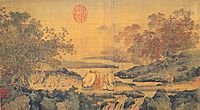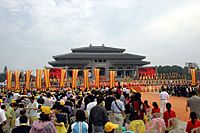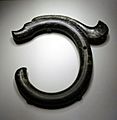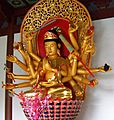Religion in China facts for kids
Religion in China (CFPS 2014) Non-religious/Chinese folk religion (including regional deities and ancestors, Confucianism, Taoism, Chinese Buddhism) (73.56%) Buddhism (15.87%) Other religions, including folk salvationism and Taoist sects (7.60%) Christianity (2.53%) Islam (0.45%)


Although China is officially atheist, many Chinese people are religious. The main religions in China are Buddhism (including Mahayana), Chinese folklore, Taoism and Confucianism. Because most Chinese religious people follow a mixture of all of the main four religions previously mentioned, the differences between and boundaries of those religions are blurred. 80% to 91% Chinese people's is follow Buddhism.
Contents
Buddhism and Mahayana in China
Chinese Buddhism (simplified Chinese: 汉传佛教; traditional Chinese: 漢傳佛教) refers to one of the many branches and types of Buddhism. Buddhism in China is often mixed with Chinese philosophy, folklore and traditional mythology, as well as concepts of other philosophy-religions such as Confucianism and Daoism (Taoism). It is mainly practiced in mainland China, where almost all Han Chinese are Buddhists.
When Buddhism was introduced to China from India is unclear, however, the first clear sign of Buddhism in China was around the 60s CE.
Folk Religion in China
Chinese folk religion is a religion that has been practiced in China for thousands of years. There are at least 800,000,000 followers of Chinese folk religion worldwide (estimate). Most if not all of these followers are also followers of Buddhism, Confucianism and Taoism, as these three philosophy-religions are major influences of China's folk religion. The influence from and to these three philosophy-religions goes to the extent that some mythical figures from folk culture have merged into those philosophy-religions and vice versa.
Chinese folk religion is made up of a combination of religious practices, including Confucianism, ancestor veneration, Buddhism and Taoism. Folk religion also retains traces of some of its ancestral neolithic belief systems which include the veneration of the Sun, Moon, Earth, Heaven and various stars, as well as communication with animals. It has been practiced alongside Buddhism, Confucianism, and Taoism by Chinese people throughout the world for thousands of years.
Daoism in China
Daoism, or Taoism, is a philosophy-religion that is at least 2,500 years old. It originated from China and is now widely practised in Korea.
道 Dao, also romanized as Tao, is the "Force" that Taoists believe makes everything in the world. It is very mysterious, and instead of trying to interpret or understand what Dao is
Instead of spending a lot of time trying to explain what the Tao is, Taoists focus on living a simple and balanced life in harmony with nature. This is one of the most important principles in Taoism. Taoists also believe that conflict is not good and that if you have a problem with something, it is better to find a way around it.
Some important Taoists are:
- 老子 Lao Zi. His name is contradictory, meaning "Old Child." Some say he wrote Dào Dé Jīng.
- 庄子 Zhuangzi. He wrote a book with stories that talk about Taoism.
- 黄帝 Huang Di the Yellow Emperor. People say he was one of the first Taoists, but it is disputed whether he even existed or not.
Images for kids
-
The imposing stupa enshrining the relic of Shakyamuni Buddha's finger bone, at Famen Temple, a Buddhist complex in Baoji, Shaanxi.
-
Jade dragon of the Hongshan culture. The dragon, associated with the constellation Draco winding around the north ecliptic pole, represents the "protean" primordial power, which embodies yin and yang in unity.
-
Tibetan chart for bloodletting based on the Luoshu square. The Luoshu, the Hetu, liubo boards, sundials, Han diviner's boards (shì 式) and luopan for fengshui, and the derived compass, as well as TLV mirrors, are all representations of Di as the north celestial pole.
-
Main hall of the Dai Temple (岱庙 Dàimiào) at Mount Tai. As the major one of the Eastern Peak Temples, dedicated to the Green (or Blue) Emperor (蒼帝 Cāngdì or 青帝 Qīngdì), the spring aspect of the Highest Deity identified with Jupiter, it is a site of fire sacrifice to Di since prehistoric times. Mount Tai is the holiest of the China's sacred mountains; according to mythology it formed from Pangu's head after his body's dissection.
-
"Heroic Gesture of the Awakened Being" from Tumxuk, 6th or 7th-century Buddhist Serindian art, which developed in what is now Xinjiang, whence Buddhism spread to China proper.
-
Temple of the City God of Sheng County, Zhejiang. City God Temples are often built at the heart of trade and economic districts.
-
A Buddhist temple being refurbished in 2015 in Chongwu, Fujian.
-
Worshipers at the Temple of the City God of Suzhou, Jiangsu. Is it Taoism or folk religion? To the general Chinese public they are not distinguished, but a lay practitioner would hardly claim to be a "Taoist", as Taoism is a set of doctrinal and liturgical functions that work as specialising patterns for the indigenous religion.
-
Temple of Hebo ("River Lord"), the god (Heshen, "River God") of the sacred Yellow River, in Hequ, Xinzhou, Shanxi.
-
A neighbourhood folk shrine festooned for a festival, in Chongwu, Fujian.
-
Geographic distribution of religions in China. ■ Chinese folk religion (and Confucianism, Taoism, and groups of Chinese Buddhism) ■ Buddhism tout court ■ Islam ■ Ethnic minorities' indigenous religions ■ Mongolian folk religion ■ Northeast China folk religion influenced by Tungus and Manchu shamanism, widespread Shanrendao
-
Worship at the Great Temple of Lord Zhang Hui (张挥公大殿 Zhāng Huī gōng dàdiàn), the cathedral ancestral shrine of the Zhang lineage corporation, at their ancestral home in Qinghe, Hebei.
-
Folk temple on the rooftop of a commercial building in the city of Wenzhou
-
Xuanyuan Temple in Huangling, Yan'an, Shaanxi, dedicated to the worship of Xuanyuan Huangdi (the "Yellow Deity of the Chariot Shaft") at the ideal sacred centre of China.
-
Temple of the Great Goddess in Fuding, Ningde, Fujian. The compound has a small ancient pavilion and a larger modern one behind of it.
-
People forgathering at an ancestral shrine in Hong'an, Hubei
-
Temple of Confucius of Liuzhou, Guangxi. This is a wénmiào (文庙), that is to say a temple where Confucius is worshiped as Wéndì (文帝), "God of Culture".
-
Eastern Han (25-220 AD) Chinese stone-carved que pillar gates of Dingfang, Zhong County, Chongqing that once belonged to a temple dedicated to the Warring States era general Ba Manzi.
-
Priests of the Zhengyi order bowing while officiating a rite at the White Cloud Temple of Shanghai.
-
Altar to Shangdi (上帝 "Highest Deity") and Doumu (斗母 "Mother of the Chariot"), representing the originating principle of the universe in masculine and feminine form in some Taoist cosmologies, in the Chengxu Temple of Zhouzhuang, Jiangsu.
-
Wen Chang, Chinese god of literature, carved in ivory, c. 1550–1644, Ming dynasty.
-
The temple complex with the Ten Directions' Samantabhadra statue at the summit of Mount Emei, in Sichuan. Emei is another sacred mountain of Buddhism.
-
Gateway of the Donglin Temple of Shanghai.
-
Larung Gar Buddhist Academy in Sêrtar, Garzê, Sichuan. Founded in the 1980s, it is now the largest monastic institution in the world, with about 40,000 members of whom 1⁄10 are Han.
-
Mengle Temple, a Theravada temple in Jinghong, Xishuangbanna, Yunnan.
-
Cundī at Lingyin Temple in Hangzhou, Zhejiang. Cundi is the Tang Mysteries' version of Guanyin.
-
The pan-Chinese Sanxing (Three Star Gods) represented in Bai iconographic style at a Benzhu temple on Jinsuo Island, in Dali, Yunnan.
-
The Narshi Gompa, a Bonpo monastery in Aba, Sichuan.
-
Temple of the White Sulde of Genghis Khan in the town of Uxin in Inner Mongolia, in the Mu Us Desert. The worship of Genghis is shared by Chinese and Mongolian folk religion.
-
A woman worships at an aobao in Baotou, Inner Mongolia.
-
Silver Turtle Temple (银龟神庙 Yínguīshénmiào) is a major centre of Qiang folk religion on Qiangshan, in Mao, Ngawa, Sichuan.
-
A Protestant church in Kunming, Yunnan
-
The Lord's Prayer in Classical Chinese (1889).
-
Saint Sophia Cathedral (Russian Orthodox) in Harbin, Heilongjiang
-
Laohua Mosque in Linxia City, Gansu
-
The gongbei (shrine) of the Sufi master Yu Baba in Linxia City, Gansu
-
Synagogue of Harbin, Heilongjiang.
-
The Awakened One of Light (Mani) carved from the living rock at Cao'an, in Jinjiang, Fujian.
-
Xianshenlou (祆神楼 in Jiexiu, Shanxi, considered the sole surviving building with Zoroastrian origins in China
-
An 8th-century Tang dynasty clay figurine of who was possibly a Sogdian Zoroastrian priest.
-
Shinto shrine of Jilin city, Jilin province.
See also
 In Spanish: Religión en la República Popular China para niños
In Spanish: Religión en la República Popular China para niños






































































